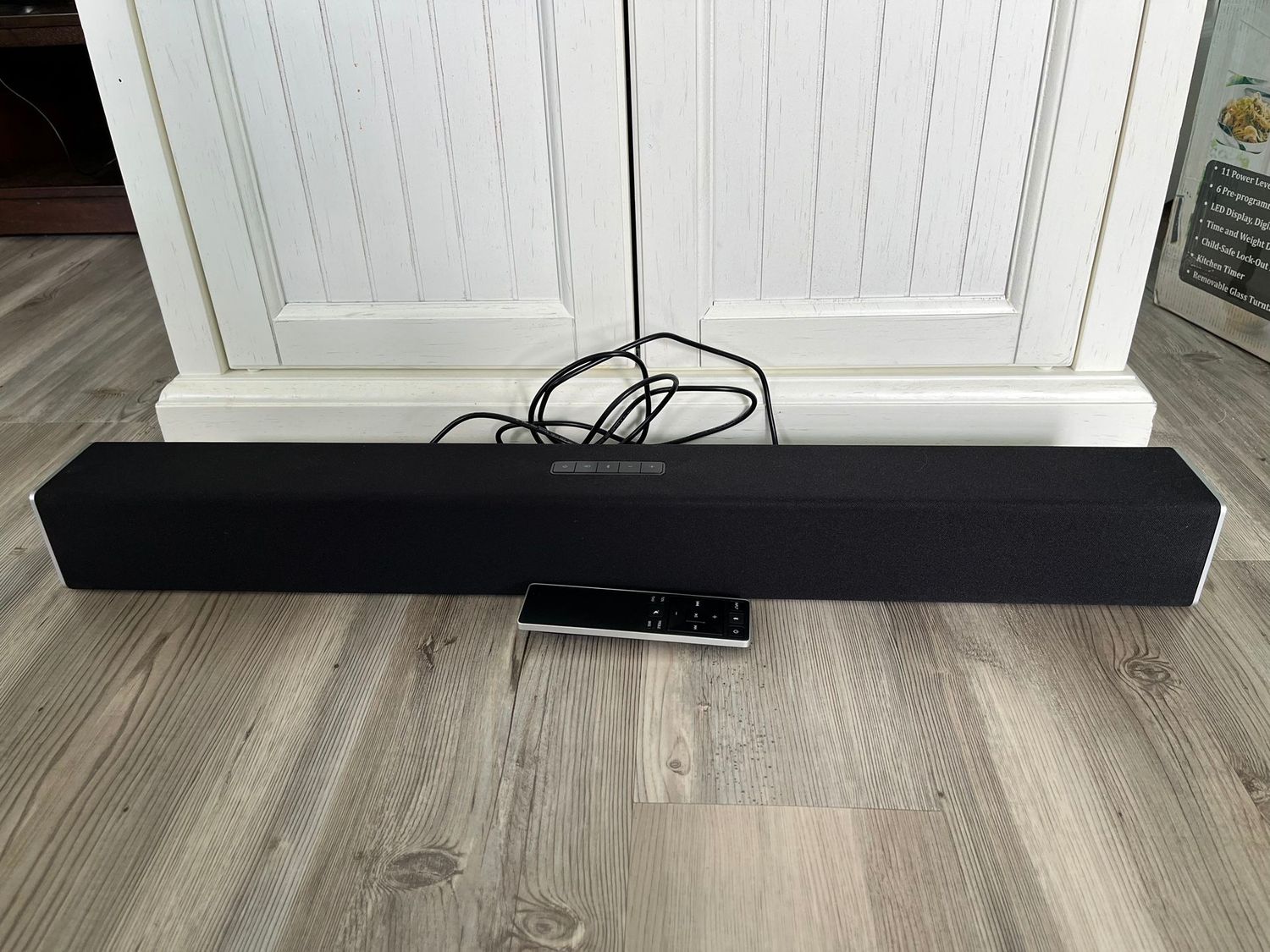Home>Devices & Equipment>Subwoofer>How Many Watts Is Good For A Subwoofer


Subwoofer
How Many Watts Is Good For A Subwoofer
Published: January 22, 2024
Discover the perfect wattage for your subwoofer to enhance your audio experience. Find out how many watts is ideal for your subwoofer and boost your bass!
(Many of the links in this article redirect to a specific reviewed product. Your purchase of these products through affiliate links helps to generate commission for AudioLover.com, at no extra cost. Learn more)
Table of Contents
- Introduction
- Understanding Subwoofer Power and Watts
- Factors to Consider When Choosing Subwoofer Power
- Matching Subwoofer Power with Amplifier Power
- Best Watts Range for Different Subwoofer Sizes
- Importance of RMS Power Rating for Subwoofers
- Understanding Impedance and Power Handling
- Subwoofer Power Recommendations for Different Applications
- Conclusion
Introduction
Subwoofers play a crucial role in any audio system, delivering deep, low-frequency sounds that add depth and impact to music, movies, and other forms of media. But when it comes to choosing a subwoofer, one of the key considerations is power. How many watts is good for a subwoofer?
Understanding the power requirements of a subwoofer is essential to ensure optimal performance and avoid damaging your equipment. In this article, we’ll delve into the world of subwoofer power and watts, exploring the factors to consider when choosing the right power level for your setup.
From home theater enthusiasts looking to recreate a cinematic experience to car audio enthusiasts seeking that intense bass sensation on the road, the appropriate amount of power for your subwoofer will vary depending on your specific needs and preferences.
Whether you’re a tech-savvy individual or a beginner in the world of audio equipment, this guide will provide you with valuable insights into subwoofer power requirements, helping you make an informed decision when selecting the ideal subwoofer for your needs.
Understanding Subwoofer Power and Watts
When it comes to subwoofers, power is typically measured in watts. Watts are a unit of power that indicate how much electrical energy is being used by the subwoofer. In simple terms, the higher the wattage rating, the more power the subwoofer can handle and the louder it can go.
Subwoofer power is divided into two main categories: RMS power and peak power. RMS power, also known as continuous power, is the average amount of power that the subwoofer can handle over an extended period. On the other hand, peak power refers to the maximum power level that the subwoofer can handle for short durations, such as during sudden bass bursts.
It’s important to note that the power rating of a subwoofer does not solely determine its performance. Other factors such as the design of the subwoofer, the quality of the components, and the enclosure type also contribute to its overall sound output.
When it comes to subwoofer power, the general rule of thumb is to match the power of the subwoofer with the power output of the amplifier. This ensures that the subwoofer is receiving adequate power to perform optimally without risking damage to the subwoofer or the amplifier.
A common misconception is that more wattage automatically translates to better sound quality or higher volume. However, it’s important to strike a balance between power and the overall quality of the subwoofer. A high-powered subwoofer matched with a low-quality amplifier may result in distorted sound or even damage to the subwoofer.
So, when choosing a subwoofer, consider factors such as your listening preferences, the size of the room or vehicle, and the type of music or media you primarily listen to. This will help you determine the appropriate power rating for your subwoofer, ensuring that you enjoy a balanced and immersive audio experience.
Factors to Consider When Choosing Subwoofer Power
Choosing the right power level for your subwoofer involves considering several factors to ensure optimal performance and compatibility with your audio system. Here are some key factors to consider when selecting subwoofer power:
- Room or Vehicle Size: The size of the room or vehicle where the subwoofer will be installed is an important factor in determining the necessary power level. Larger spaces often require more power to fill the area with deep, impactful bass.
- Listening Preferences: Consider your personal listening preferences. If you enjoy listening to music or watching movies with powerful, chest-thumping bass, you may need a subwoofer with higher wattage to deliver the desired impact.
- System Compatibility: Ensure that the subwoofer you choose is compatible with your existing audio system. Check the power output of your amplifier and make sure it can provide enough power to drive the subwoofer effectively.
- Music Genres: Different music genres have varying levels of bass content. If you primarily listen to genres such as hip-hop, EDM, or dubstep that heavily rely on deep bass, a subwoofer with higher power is recommended to reproduce those low frequencies accurately.
- Enclosure Type: The type of enclosure used for the subwoofer can affect its performance and power handling. Sealed enclosures generally require less power compared to ported or bandpass enclosures. Consider the recommended power specifications provided by the manufacturer for the specific enclosure type.
- Budget: Another crucial factor to consider is your budget. Subwoofers with higher power ratings tend to be more expensive. Assess your budgetary constraints and choose a subwoofer that strikes a balance between power and affordability.
By taking these factors into account, you can make an informed decision regarding subwoofer power, ensuring that you select a subwoofer that meets your specific needs and provides an immersive audio experience.
Matching Subwoofer Power with Amplifier Power
One crucial aspect of setting up a subwoofer is ensuring that the power output of the amplifier matches the power requirements of the subwoofer. Matching these power levels effectively is essential for optimal performance and to prevent damage to your equipment.
The power output of an amplifier is usually measured in watts, just like subwoofers. You’ll find the amplifier’s power rating listed as RMS power, which indicates the continuous power it can supply to the subwoofer over extended periods.
To match the subwoofer power with the amplifier power, consider the following guidelines:
- Amplifier Power Equal to or Slightly Higher: It is generally recommended to use an amplifier with a power output equal to or slightly higher than the power handling capacity of the subwoofer. This ensures that the subwoofer can receive enough power to deliver its full potential and prevents underpowering, which can result in distortion and poor performance.
- Subwoofer Power Handling Range: Pay attention to the power handling specifications provided by the subwoofer manufacturer. They typically indicate a range of power (in watts) within which the subwoofer can operate optimally. Aim to select an amplifier within this power range to ensure a proper match.
- Impedance Matching: Consider the impedance (measured in ohms) of both the subwoofer and the amplifier. It’s important to match the impedance to ensure the best performance. Most subwoofers have a nominal impedance of 4 or 8 ohms, so choose an amplifier that can handle the same impedance.
- Bi-amplification or Subwoofer Output: If you have a more advanced setup with a separate amplifier dedicated to the subwoofer, make sure the amplifier has a dedicated subwoofer output or supports bi-amplification. This allows you to directly connect the subwoofer and optimize its performance.
Matching the subwoofer power with the amplifier power is crucial for achieving the best sound quality, preventing distortion, and protecting your equipment. It’s important to carefully consider the power requirements of both components to ensure compatibility and maximize the performance of your subwoofer system.
Best Watts Range for Different Subwoofer Sizes
When it comes to subwoofers, the size of the driver plays a significant role in determining the ideal power range. Different subwoofer sizes have varying power requirements to deliver optimal performance and bass reproduction. Here are some general guidelines for the best watts range based on different subwoofer sizes:
- 8-Inch Subwoofers: 8-inch subwoofers are commonly found in compact audio systems, including car audio setups. For an 8-inch subwoofer, a power range of 100 to 300 watts RMS is typically recommended. This power range provides enough depth and impact for small to medium-sized spaces.
- 10-Inch Subwoofers: 10-inch subwoofers are popular choices for both car audio and home theater setups. A power range of 200 to 500 watts RMS is often considered optimal for 10-inch subwoofers. This range offers a balance between deep bass performance and power handling.
- 12-Inch Subwoofers: 12-inch subwoofers are versatile options that work well in various audio systems. The recommended power range for 12-inch subwoofers is typically between 300 to 700 watts RMS. This range allows for impactful bass response and is suitable for medium to large-sized rooms or vehicles.
- 15-Inch Subwoofers: 15-inch subwoofers are known for their ability to produce deep, powerful bass. To achieve their full potential, 15-inch subwoofers usually require a power range of 500 to 1000 watts RMS. This power range ensures that the subwoofer can handle the demanding low frequencies without distortion.
- 18-Inch Subwoofers: 18-inch subwoofers are typically used in professional audio setups, such as concert venues and large-scale events. These subwoofers need substantial power to deliver the required bass output. A power range of 1000 to 2000 watts RMS is often recommended for 18-inch subwoofers.
It’s important to note that these power ranges are general recommendations, and the specific power requirements may vary depending on the sensitivity and design of the subwoofer. Be sure to consult the manufacturer’s specifications for the subwoofer you intend to use, as they will provide the most accurate information regarding power requirements.
By selecting a subwoofer within the appropriate power range for its size, you can ensure optimal performance and enjoy the full range of deep, immersive bass that these speakers are capable of delivering.
Importance of RMS Power Rating for Subwoofers
When considering the power rating of a subwoofer, the RMS (Root Mean Square) power rating is one of the most important specifications to pay attention to. The RMS power rating indicates the continuous power that a subwoofer can handle over an extended period without distortion or damage.
The RMS power rating is crucial as it provides a reliable and realistic measure of the subwoofer’s power handling capabilities. Unlike peak power ratings, which represent the maximum power a subwoofer can handle for short bursts, the RMS power rating reflects the sustained power handling capacity of the subwoofer.
Here are some key reasons why the RMS power rating is important when selecting a subwoofer:
- Accurate Power Measurement: The RMS power rating gives you an accurate measure of the continuous power capacity of the subwoofer. It represents the average power that the subwoofer can handle without compromising performance or risking damage.
- Maintaining Sound Quality: Operating a subwoofer within its RMS power range ensures that the speaker can reproduce deep bass frequencies accurately and without distortion. Underpowering or overpowering a subwoofer can lead to poor sound quality, muffled bass, or even damaged voice coils.
- Protection Against Damage: Exceeding the RMS power rating of a subwoofer can push the speaker beyond its capabilities, potentially causing it to overheat, blow out, or suffer from other mechanical failures. Adhering to the RMS power rating helps protect your investment and ensures the longevity of your subwoofer.
- Compatibility with Amplifier: Matching the RMS power rating of the subwoofer with the power output of your amplifier is essential. Using an amplifier that provides the appropriate continuous power ensures a proper balance and prevents underpowering or overpowering the subwoofer.
- Consistent Performance: By operating a subwoofer within its recommended RMS power range, you can maintain consistent performance and prevent fluctuations in output quality. This allows you to enjoy a stable, well-defined bass response across different audio sources.
It’s important to note that while the RMS power rating is crucial, it should be considered in conjunction with other factors such as sensitivity, impedance, and enclosure design. These factors collectively contribute to the overall performance and power handling capabilities of the subwoofer.
When selecting a subwoofer, pay close attention to the RMS power rating to ensure that it aligns with your desired performance level, amplifier capabilities, and listening needs. By doing so, you can ensure a seamless integration into your audio system and enjoy optimal bass reproduction.
Understanding Impedance and Power Handling
Impedance and power handling are two critical factors to consider when selecting a subwoofer. Understanding how these attributes relate to one another is essential for optimizing the performance and longevity of your audio system.
Impedance refers to the resistance that the subwoofer presents to the amplifier’s output. It is measured in ohms and can affect the power delivery and overall performance of the subwoofer. Common impedance values for subwoofers are 4 ohms and 8 ohms, although other values may also exist.
The power handling capability of a subwoofer refers to the maximum amount of power it can handle without experiencing damage or distortion. It is usually specified as a range in watts, with the RMS power rating being the important consideration for continuous power handling.
The relationship between impedance and power handling can be understood as follows:
1. Impedance and Power Output: The impedance of the subwoofer affects the power output of the amplifier. As impedance decreases, the amplifier must deliver more current to maintain the same power output. Lower impedance subwoofers may require amplifiers capable of delivering higher currents to achieve the desired power level.
2. Power Transfer Efficiency: The impedance of the subwoofer also affects the efficiency of power transfer from the amplifier to the subwoofer. In general, a lower impedance subwoofer will allow for higher power transfer efficiency, resulting in more effective use of amplifier power and potentially louder sound output.
3. Power Handling and Impedance: The power handling capability specified by the manufacturer is typically given at a specific impedance. It’s essential to consider this when selecting an amplifier to ensure that the amplifier’s power output matches the subwoofer’s power handling capability at the given impedance.
When matching an amplifier to a subwoofer, it is crucial to consider both impedance compatibility and power handling. A well-matched combination ensures efficient power transfer, prevents underpowering or overpowering, and maximizes performance.
It’s important to note that a mismatch between the subwoofer’s impedance and amplifier’s output can result in poor sound quality, reduced power delivery, and potential damage to the equipment.
Always refer to the specifications provided by both the subwoofer and amplifier manufacturers to ensure that the impedance and power handling requirements are accurately met. These specifications will guide you in selecting the right amplifier to achieve optimal performance and longevity for your subwoofer.
Subwoofer Power Recommendations for Different Applications
Subwoofers are utilized in various applications, ranging from home theater systems to car audio setups. The power requirements for a subwoofer can vary depending on the specific application and the desired listening experience. Here are some subwoofer power recommendations for different applications:
- Home Theater Systems: For a home theater setup, where the aim is to replicate the immersive cinematic experience, it’s generally recommended to opt for a subwoofer with higher power handling capabilities. A power range of 300 to 1000 watts RMS will provide the desired impact and bass depth, especially for larger rooms.
- Music Listening: If your primary focus is music listening, the power requirements may vary based on the music genres you enjoy. Subwoofers with power ratings between 200 to 500 watts RMS are often suitable for music enthusiasts, providing a balanced and deep bass response across various genres.
- Car Audio Systems: Car audio installations typically have space limitations, which can impact the overall bass performance. Compact subwoofers with lower power requirements, ranging from 100 to 500 watts RMS, are commonly used in vehicles. The specific power needs may also depend on the size and acoustics of the vehicle.
- Live Sound Reinforcement: In professional audio applications such as live sound reinforcement for concerts or events, large venues require subwoofers with substantial power handling capabilities. Power ranges of 1000 watts RMS and above are common to deliver the necessary low-end extension and impact.
- Studio Recording: In studio recording environments, accurate and precise bass reproduction is crucial. Subwoofers with moderate power ratings between 200 to 500 watts RMS are often used to ensure a well-balanced mix and to aid in accurate monitoring during the recording and mixing process.
These power recommendations are general guidelines based on typical scenarios. However, it’s important to note that personal preferences, room or vehicle size, budget, and the specific subwoofer’s design and sensitivity also play a role in determining the appropriate power requirements.
Always refer to the manufacturer’s specifications and recommendations for the subwoofer you intend to use, as they provide valuable insights into the optimal power range for the specific model.
By considering the application-specific power recommendations and tailoring them to your individual needs, you can ensure that your subwoofer delivers the desired bass performance and enhances your listening or audio experience to its fullest potential.
Conclusion
Choosing the right power level for a subwoofer is a crucial step in creating an immersive audio experience. Understanding the concepts of subwoofer power and watts, as well as considering various factors, enables you to make an informed decision that aligns with your specific needs and preferences.
By matching the power of the subwoofer with the amplifier, considering the size and requirements of the room or vehicle, and taking into account personal listening preferences, you can ensure optimal performance and prevent damage to your equipment.
For different subwoofer sizes, there are recommended power ranges, such as 100 to 300 watts RMS for 8-inch subwoofers, or 300 to 700 watts RMS for 12-inch subwoofers. These ranges provide a starting point, but it’s important to always consult the manufacturer’s specifications for the specific subwoofer you’re considering.
Understanding the importance of the RMS power rating, impedance, and power handling allows you to make educated decisions when matching subwoofers with amplifiers, ensuring efficient power transfer and consistent performance.
Lastly, the recommended power for different applications, such as home theater systems, car audio setups, or studio recording, enables you to select a subwoofer that suits your specific needs and provides an optimal bass experience.
Remember, when it comes to subwoofer power, it’s crucial to strike a balance between providing enough power for the subwoofer to perform at its best, while being mindful of compatibility, sound quality, and budget constraints.
By considering these factors and making thoughtful choices, you can enjoy the deep, impactful bass that subwoofers bring to your audio system, whether it’s for music, movies, or other forms of media.











